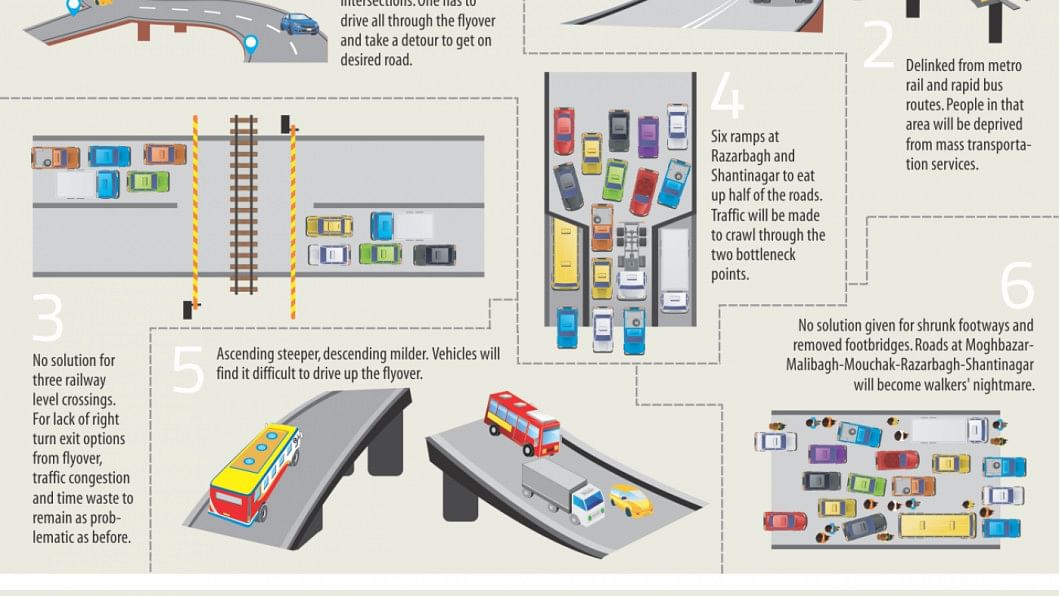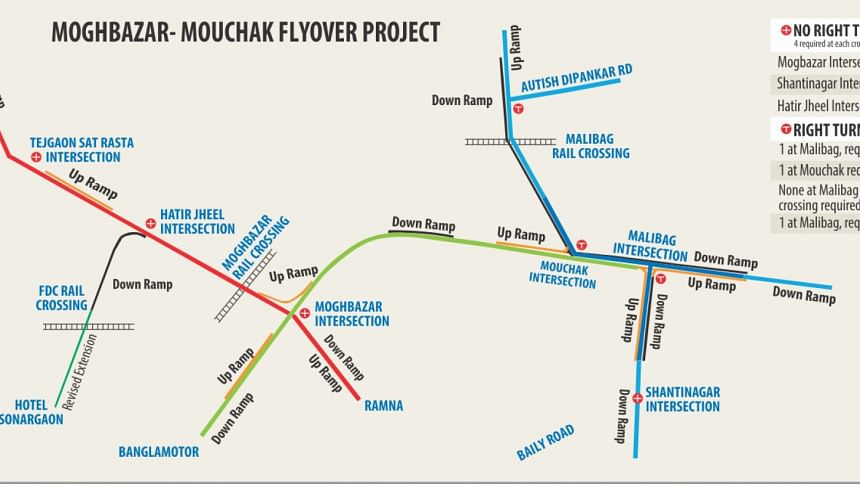Concrete block in city's heart

Once built, the 8.70km Moghbazar-Mouchak flyover is set to become a permanent woe for Dhaka, with leading experts describing the Tk 1,219 crore structure as a massive block in the heart of the city.
Around a year into the construction work in early 2014, it was detected by sheer chance that the much-hyped flyover was being built on a grossly faulty layout configuration without vital right-turn provisions and had a number of other flaws with serious consequences.
Now, three years into its construction work, the flyover is found to have an architectural layout design not approved by the central transportation coordination authority, and its detailed design was also not vetted by an independent consultant, sources confirmed.
The Local Government Engineering Department (LGED), builder of the flyover, ignored the mandatory approval and vetting processes of the scheme's proposed configuration, which has nearly half a dozen critical flaws. The flaws would make the chronic traffic congestion in the project area even messier, said experts.
The LGED did not hold a public consultation on the project either.
It had the design developed in 2005 by a team of three companies.
But, before the project went underway eight years later, the LGED did not get the flawed layout synched to the design of four major mass transportation routes of metro rail and Bus Rapid Transit (BRT), which were recommended in the same alignment in the transport master plan of 2008.
The project has not undergone road safety auditing either even though it is required under the 2005 Guidelines for Road Safety, said official sources.
Even worse, the flaws are beyond correction as scores of gigantic concrete piers and extremely sturdy underground pilings would have to be demolished, which is, according to experts, technically almost impossible and financially a colossal waste.
The project could be seen as a landmark case of governance failure. The LGED pushed ahead without obtaining mandatory approval from Dhaka Transport Coordination Authority (DTCA), which surprisingly is reluctant to hold the LGED responsible.
“We cannot be hostile towards a government organisation like the LGED. Moreover, the Planning Commission and Executive Committee of the National Economic Council chaired by the prime minister had already approved the project,” DTCA Adviser ATM Helaluddin Nagari told The Daily Star.
DTCA Executive Director Kaikobad Hossain said, “We could not take [legal] action as a ministry was involved.”
Project Director of the flyover Nazmul Alam, however, said, “The project had DTCA approval.” He stood his ground when mentioned that two officials of DTCA had told The Daily Star that the project did not have its approval. Nazmul didn't show this newspaper any document in this regard.
Against this backdrop, The Daily Star approached eminent transport engineering expert Prof Shamsul Hoque and raised a number of technical questions on the flyover.

Responding to a question, Prof Hoque, who drew the layout configuration of Kuril flyover and Banani-Zia Colony flyover, said, “The flyover will hardly help resolve the chronic traffic congestion in the project area. Instead, it will remain an irreversible and immoveable block to the capital's mass transport systems like metro rail and rapid bus service.”
Even Nazmul agrees on this. “It is true that the flyover will not make any significant contribution to the public transportation service,” he said.
The LGED has expertise in building roads and highways in rural areas, not flyovers in the complex environment of a metropolis. And yet it did not get experts to vet the layout.
The LGED with a decade-old layout plan embarked on implementing the scheme without vetting the configuration in early 2013 and hired a team of Buet experts eight months later to scrutinise only a small part of the construction design.
The experts were asked to do the scrutiny amid the ongoing heavy construction work, underground piling work, and with a number of piers already built.
The Buet team, of which Prof Hoque was a member, voluntarily looked into the entire layout configuration and discovered the gross anomalies in it and drew the attention of LGED project officials.
Sadly, the construction went ahead without any correction, an action that forced the authorities concerned to spread out links and routes of the proposed BRT and metro rail to peripheral areas like Bhulta, Baipal, and Purbachal.
The flyover, instead of resolving traffic bottleneck in Mouchak, Malibagh, Moghbazar, and Shanti Nagar intersections, will exclude the areas from BRT and metro rail services, said Prof Hoque, a technical expert on Strategic Transport Plan (STP) of Dhaka.
The BRT and metro rail are well-thought-out and sustainable transport solutions in the metropolis.
Prof Jamilur Reza Choudhury, who led the advisory expert committee on Dhaka's STP, is also in the dark. “We know nothing about the project design,” he said.
Asked why the scheme was going on without key approvals, Nazmul said, “We are implementing the project with government approval.”
As to why they had not held a public consultation on the flyover scheme, Nazmul said, “It was not required in the approval process.”
Public consultation may not be legally required but it is practised around the world in public interest to avoid major faults and anomalies in any large project, particularly one in a complex urban context, said Prof Hoque, citing examples of Kuril flyover, the BRT, and the metro rail.
Lack of coordination between the flyover and mass transport systems, faulty architectural layout, and inadequate right-turn provisions would have been exposed had it gone through DTCA approval process or a public consultation or an independent scrutiny, said officials concerned.
Heavy traffic of public transport vehicles from Motijheel, Shanti Nagar, Rajarbagh, and Mouchak would have no option to turn right towards Tejgaon at Moghbazar intersection.
Nazmul said, “Right-turn loops could not be built, as it would entail land acquisition and huge demolition.” He said they had to alter the construction design of every foundation piling and pier due to lack of information on underground utility service lines.
Ascending ramps of the flyover have been designed with steeper slopes while the descending ones were less steep, which should have been the other way round, said Prof Hoque. It would make climbing the ramps difficult for less powerful vehicles.
He said the slope of the ascending ramps was “standard” with five-percent ascending ration. But Prof Hoque said anything less than the standard five-percent was more convenient for traffic movement.
The flyover ramps are going to occupy a 21-metre width with three descending and ascending ramps each at Shanti Nagar and Rajarbagh ends, creating bottlenecks and leaving hardly any room for traffic movement, said Prof Hoque, replying to another question.
Vehicles would still have to crawl on a road that would be even narrower.
The flyover would not either reduce the risks at level crossings as most of the traffic would be using the existing roads due to the lack of right-turn facilities of the flyover, said experts.
Pedestrians would have to suffer as foot bridges would need to be removed at Moghbazar and Mouchak and pavements shrunk in Rajarbagh and Shanti Nagar to accommodate the ramps.
LGED
The LGED approved the layout and detailed design on its own, according to insiders. After the construction had begun, they called in Robert Eves, chief adviser of China Major Bridge Engineering Company Ltd, to oversee the flyover's construction design.
This was done since Eves was not busy with Padma Bridge construction which was stalled then.
Nazmul said they hired Eves to review the entire design, and he examined “both the layout configuration and construction design”.
Eves had nothing to do with the layout configuration after a decade, said insiders. As a structural engineer, he was assigned to scrutinise the construction design.
The Daily Star could not get LGED Chief Engineer Shyama Prosad Adhikari's comments regarding the matter, especially as to why they did not obtain the DTCA approval.
He neither picked up calls from this paper nor did he respond to texts sent on January 3 and 4.
LGED media consultant Abu Fattah was contacted several times but he could not get this paper in touch with the chief engineer.
Attempted yet again on January 6, Shyama Prosad Adhikari picked up a call at 4:00pm but said, “I am busy in a meeting.” Asked when this paper should call him, he hung up.
Local Toma Constructions Ltd, allegedly blessed by a state minister, Chinese firm Metallurgical Construction Overseas Company, and joint venture of Indian Simplex Infrastructure Ltd, and local Navana Construction are building the flyover.
According to insiders, a state minister pushed the scheme forward to serve the interest of another state minister.

 For all latest news, follow The Daily Star's Google News channel.
For all latest news, follow The Daily Star's Google News channel. 








Comments